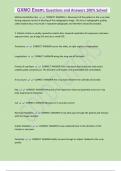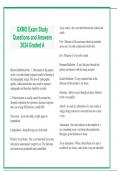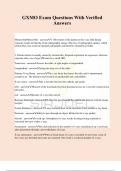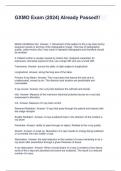Motion blurmotion blur Study guides, Class notes & Summaries
Looking for the best study guides, study notes and summaries about Motion blurmotion blur? On this page you'll find 4 study documents about Motion blurmotion blur.
All 4 results
Sort by

-
GXMO Exam; Questions and Answers 100% Solved
- Exam (elaborations) • 25 pages • 2024
- Available in package deal
-
- $14.99
- + learn more
GXMO Exam; Questions and Answers 100% Solved Motion blurMotion blur CORRECT ANSWER-1. Movement of the patient or the x-ray tube during exposure results in blurring of the radiographic image. This loss of radiographic quality, called motion blur, may result in repeated radiographs and therefore should be avoided. 2. Patient motion is usually caused by motion blur. Suspend respiration for exposures, decrease exposure time, use a large SID and use a small OID. Transverse CORRECT ANSWER-acr...

-
GXMO Exam Study Questions and Answers 2024 Graded A
- Exam (elaborations) • 17 pages • 2024
-
Available in package deal
-
- $13.99
- + learn more
Motion blurMotion blur - 1. Movement of the patient or the x-ray tube during exposure results in blurring of the radiographic image. This loss of radiographic quality, called motion blur, may result in repeated radiographs and therefore should be avoided. 2. Patient motion is usually caused by motion blur. Suspend respiration for exposures, decrease exposure time, use a large SID and use a small OID. Transverse - across the table, at right angles to longitudinal. Longitudinal - along th...
GXMO Exam (2024) Already Passed!!

-
GXMO Exam Questions With Verified Answers
- Exam (elaborations) • 17 pages • 2024
-
- $12.49
- + learn more
GXMO Exam Questions With Verified Answers Motion blurMotion blur - answer1. Movement of the patient or the x-ray tube during exposure results in blurring of the radiographic image. This loss of radiographic quality, called motion blur, may result in repeated radiographs and therefore should be avoided. 2. Patient motion is usually caused by motion blur. Suspend respiration for exposures, decrease exposure time, use a large SID and use a small OID. Transverse - answeracross the table, at r...

How much did you already spend on Stuvia? Imagine there are plenty more of you out there paying for study notes, but this time YOU are the seller. Ka-ching! Discover all about earning on Stuvia



